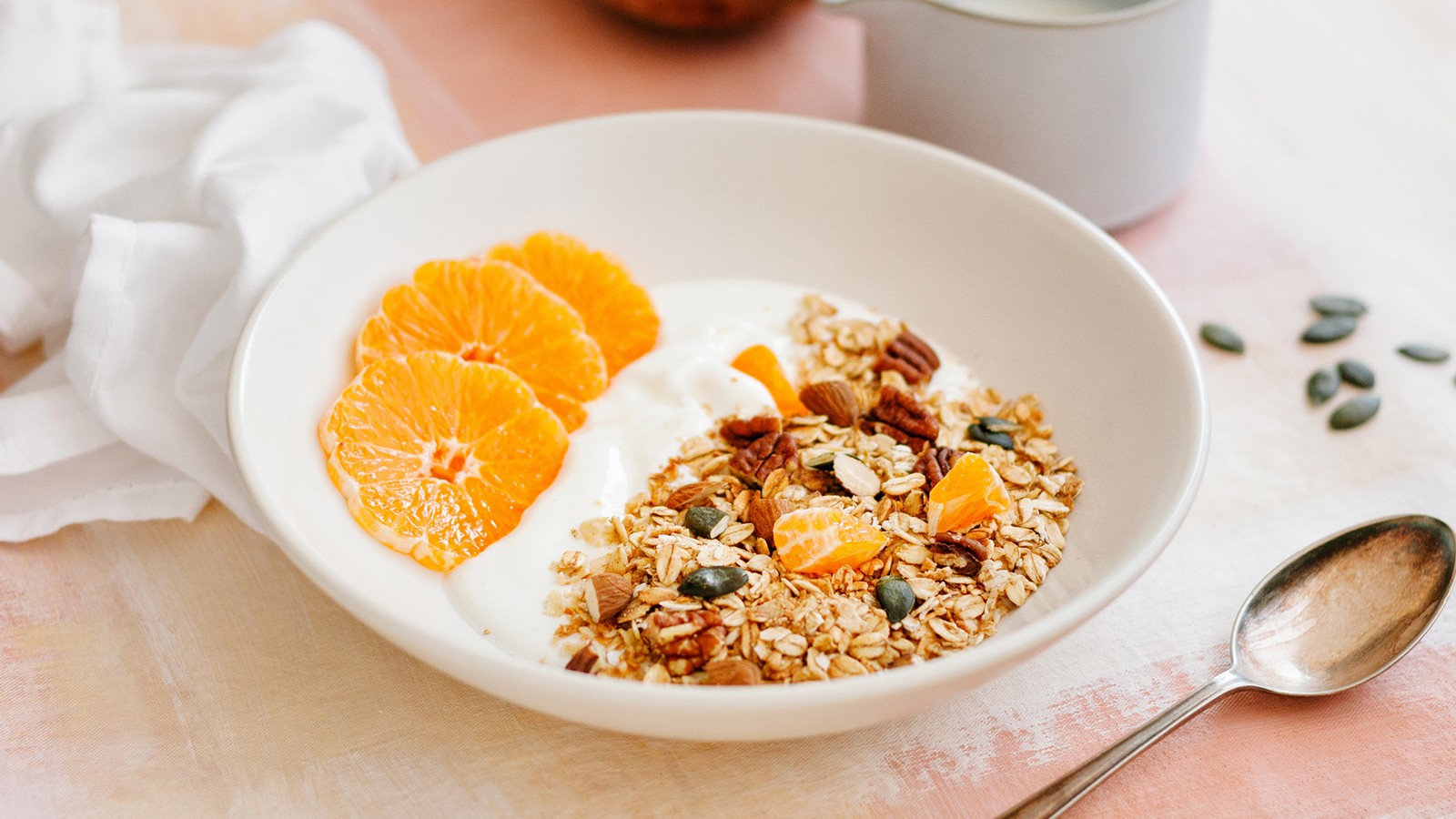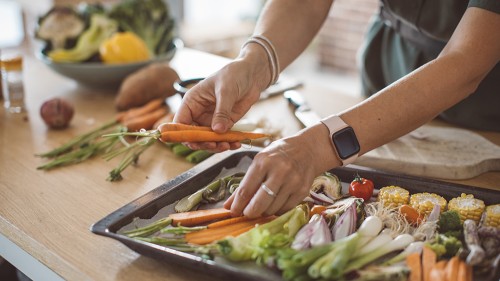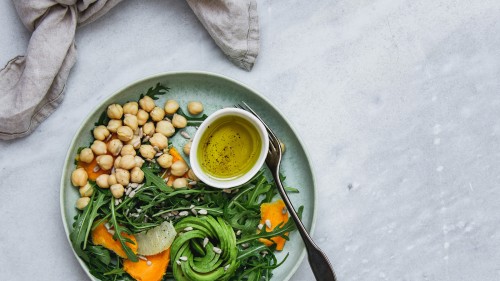DASH Diet: A Complete Beginner’s Guide
Published on April 12, 2021
Medically Reviewed by Ana Reisdorf, MS, RD
The DASH diet is one of the best-researched dietary eating patterns. As a dietitian, I would recommend this plan for anyone looking for a healthy way to eat through their lifespan.


The DASH Diet, or Dietary Approaches to Stop Hypertension, is a highly researched way of eating that helps reduce the risk of chronic diseases, including hypertension.
Our beginner’s guide has everything you need to help you get started with DASH.
What Is the DASH diet?
DASH was designed in the 1990s by the National Institutes of Health (NIH). (1)
This diet’s goal was to discover ways to decrease and prevent high blood pressure (hypertension) in patients without the use of medication.
Since then, dozens of well-designed studies have shown that DASH followers experience health benefits well beyond improved blood pressure readings.
DASH can help improve:
- Cardiovascular disease risk (2)
- Stroke risk (2)
- Insulin sensitivity in type 2 diabetes patients (3)
- Low-density lipoprotein levels (also known as “bad” cholesterol) (4)
- Inflammatory markers (5)
While the DASH diet was not designed as a weight loss plan, many followers lose weight based on healthier food choices compared to previous habits. (6)
Weight loss has been especially successful when DASH is modified into a lower-calorie plan.
DASH incorporates several approaches to achieve these health goals, including:
- Focusing on nutrient-dense foods, including whole grains, fruits, vegetables, low-fat dairy, nuts, and seeds.
- A special focus on eating foods high in magnesium, potassium, and calcium.
- Limiting sodium in the diet.
- Limiting foods high in saturated fats and added sugar.
Sweet treats are not excluded from DASH, but followers are encouraged to choose the healthiest options possible to gain the most benefit from the plan.
What to Eat on the Diet
DASH focuses on nutrient-dense foods which are readily available at grocery stores. The plan doesn’t eliminate any food groups or macronutrients.
DASH encourages selecting favorites from each category and allows for sweet treats, making the plan more enjoyable and sustainable.
For each food group, the DASH diet includes:
Whole Grains
Whole grains are rich in several nutrients, including potassium, thiamin, and fiber.
While grains have gotten a bad reputation because of misinformation in some low-carb fad diets, whole grains provide healthy carbohydrates that also help to feed the gut microbiome.
DASH recommends 6–8 servings of grains daily and encourages users to make at least half of them whole grains.
Portion sizes for whole grains are:
- 1/2 cup cooked grains
- 1 slice of whole-grain bread
Fruits and Vegetables
Fruits and vegetables are packed with nutrients we need, some of which we haven’t even discovered yet. Choose a wide variety of colors every day to gain the most benefit.
DASH recommends 4–5 servings each of fruits and vegetables daily.
Portion sizes are:
- 1 cup raw leafy vegetables
- 1/2 cup cooked vegetables
- 1 small-medium piece of fruit
- 1/2 cup canned fruit
- 1/4 cup dried fruit
Dairy
Dairy may be best known for being rich in calcium, but it is also a convenient source of potassium and protein.
DASH recommends 2–3 servings of low-fat or fat-free dairy daily.
Portion sizes are:
- 1 cup milk
- 1 oz cheese
- 6 oz yogurt
Lean Meat, Poultry, and Fish
While there are vegetarian versions of DASH, meat, poultry, and fish provide an easy way to get high-quality protein.
Also, consider that some fish like canned sardines and salmon are among the best sources of omega-3 fatty acids and calcium.
DASH recommends no more than 6 oz of lean protein spread throughout the day.
Portion sizes are:
- 3 oz meat
- 3 oz fish
- 3 oz poultry
Nuts, Seeds, Legumes
Nuts, seeds, and legumes can be fabulous sources of nutrition and are often good sources of DASH recommended potassium and magnesium.
DASH recommends 4–5 servings of nuts, seeds, and legumes weekly.
Portion sizes are:
- 1/4 cup nuts or seeds
- 1/2 cup cooked beans
Fats and Oils
We need fat, but when it comes to human nutrition, not all fats and oils are created equally.
Choose unsaturated varieties that are liquid at room temperatures, such as olive or canola oil, instead of saturated fat like butter.
Go lightly – one tablespoon packs over 100 calories in its tiny package.
DASH recommends no more than 2–3 servings of fats and oils daily, including what is used in cooking.
Portion size:
- 1 Tablespoon
Sweet Treats
Sweets are an enjoyable part of life for many of us. Rather than eliminate them from the plan, DASH simply encourages eating sweets sparingly as well as choosing low-fat, lower added sugar, and higher nutrient options.
For example:
- Choose strawberries with a small piece of angel cake over chocolate cake
- Choose real fruit sorbet over full-fat ice cream
Focus on Foods High in Magnesium, Potassium, and Calcium
Research shows that getting adequate amounts of potassium, magnesium, and calcium can help keep blood pressure under control, but these nutrients serve many other purposes.
Consider foods that are high in these micronutrients when making daily choices.
Potassium
Potassium is an electrolyte associated with many health benefits, including the power to reduce blood pressure. (7)
It’s essential for cell function, muscle function, and regulation, including the heart, and making protein.
DASH recommends getting 4,700 mg of potassium daily. While bananas may be the most popular source of potassium, it can be found in a variety of fruits, vegetables, whole grains, and pulses.
Some of the best sources of potassium include avocados, cantaloupe, dried peaches and apricots, tomatoes, sweet potatoes, potatoes, bananas, white beans, pinto beans, spinach, beet greens, swiss chard, dairy, clams, and salmon.
Magnesium
Magnesium is important for regulating blood pressure and nerve and muscle function, as well as being an assistant in hundreds of enzyme reactions.
Magnesium has recently been heavily marketed as a supplement, but we can usually get what we need from food. DASH recommends getting 500 mg of magnesium daily.
Good sources of magnesium include pumpkin seeds, almonds, spinach, black beans, and peanuts.
Calcium
Best known as a mineral for building bone and teeth strength, calcium is also important for muscle movement, nerve messaging, and helping vessels carry blood throughout the body.
DASH recommends getting 1,250 mg of calcium daily.
Dairy is one great source of calcium, but there are many other sources.
Good sources of calcium include dairy foods, fortified soy beverages, fortified orange juice, tofu, sardines, canned salmon with bones, spinach, beet greens, turnip greens, collard greens, and kale.
Reduce Sodium
Research shows that keeping sodium in check is one of the best ways to reduce blood pressure.
DASH has a reputation for being a low sodium diet; however, the standard DASH plan simply follows the Dietary Guidelines for Americans, which recommends no more than 2300 mg daily.
This equals about one teaspoon. It’s been estimated that Americans who don’t watch their sodium intake get much more than that, at about 3400 mg daily.
The worst offender is not the salt shaker. Sodium is hidden in processed foods and fast foods.
For example, it’s not unusual to find over 800 mg in one serving of canned soup; double that to 1600 mg if the entire can is consumed.
While the standard DASH diet has been proven to reduce blood pressure when sodium is limited to 2300 mg per day, hypertension has been reduced even further by limiting sodium to a 1500 mg DASH plan.
Keep in mind that the human body does need sodium to function. Completely eliminating sodium from your diet is dangerous and not recommended.
Reducing Saturated Fats, Trans Fats, and Added Sugar
While there are several popular diet plans today that pack fat into every bite, DASH is not one of them.
Instead, DASH concentrates on nutrient-dense and diverse foods, encouraging users to be choosy when it comes to fat calories.
Choosing unsaturated fats for cooking, like canola and olive oil, over butter makes fat functional instead of just a dense energy source.
Added sugar isn’t just what you used to add to your oatmeal in the morning. It can be found in lots of processed foods throughout the grocery store.
The new food labels are designed to help consumers see which processed foods add sugar in addition to what nature provides.
Sample One-Day Meal Plan
DASH Daily Goals:
- Sodium: <2300 mg
- Potassium: >4700 mg
- Magnesium: >500 mg
- Calcium: >1250 mg
Breakfast: Loaded Oatmeal
- 1/2 cup oatmeal (sodium: 85 mg; potassium: 150 mg)
- 1 cup skim milk (sodium: 100 mg; potassium: 362 mg; calcium: 300 mg)
- 1/2 banana (potassium: 225 mg; magnesium: 17mg; calcium: 3 mg)
- 1/4 cup pumpkin seeds (potassium: 282 mg; magnesium: 198mg; calcium: 19 mg)
- 1 cup calcium-fortified orange juice (sodium: 5 mg; potassium: 443 mg; magnesium: 27 mg; calcium: 349 mg)
Lunch: Mediterranean Bowl
- 2 cups fresh chopped spinach (potassium: 166 mg; magnesium: 24 mg; calcium: 30 mg)
- 2.5 oz Greek yogurt (sodium: 28 mg; potassium: 100 mg; magnesium: 10 mg; calcium: 80 mg)
- 1/4 cup hummus (sodium: 200 mg; potassium: 230 mg; magnesium: 87 mg; calcium: 45 mg)
- 1/2 cup tomatoes (sodium: 4 mg; potassium: 9 mg; magnesium: 9 mg; calcium: 8 mg)
- 3 oz baked chicken breast (sodium: 360 mg; potassium: 29 mg; magnesium: 29 mg; calcium: 7 mg)
- 1 cup quinoa (sodium: 13 mg; potassium: 318 mg; magnesium: 118 mg; calcium: 31 mg)
Snack:
- 1 small apple (sodium: 2 mg; potassium: 177 mg; magnesium: 8 mg; calcium: 10 mg)
- 2.5 oz Greek yogurt (sodium: 28 mg; potassium: 100 mg; magnesium: 10 mg; calcium: 80 mg)
Dinner: Salmon Meal
- 3 oz baked salmon with garlic and lemon (sodium: 371 mg; potassium: 309 mg; magnesium: 27 mg; calcium: 202 mg)
- 2 cups swiss chard (potassium: 960 mg; magnesium: 150 mg; calcium: 102 mg)
- 1 cup brown rice (sodium: 10 mg; magnesium: 105 mg; calcium: 25 mg)
- 1 small baked potato (sodium: 6 mg; potassium: 1,230 mg; magnesium: 25 mg; calcium: 35 mg)
- 1 tablespoon butter (sodium: 85 mg)
- 1/2 teaspoon table salt for seasoning (sodium: 1,150 mg)
Shopping and Cooking Tips
General shopping tips:
- Before shopping, make weekly menus that cover all meals.
- Be budget-friendly by planning your menu around grocery store sales, signing up for grocery store apps, and choosing healthful frozen options when acceptable in recipes.
- Plan meals with perishable fresh produce first, saving frozen items for the end of the week.
- Make a grocery list of only what you need and stick to it. Include portion sizes in your list.
- Shop the perimeter of the grocery store, which generally has the healthiest items.
General cooking tips:
- Use non-stick pans to reduce the amount of oil you need to cook with.
- Stick with serving size portions for each person when cooking, with the exception of extra vegetables for those who want seconds.
Shopping tips for nutrient density:
- Fresh produce is only best if it has been very recently harvested. Frozen sources generally lock in the nutrients by freezing foods the day they’re picked.
- In general, canned produce has the least amount of nutrient value than fresh or frozen because it has to be cooked at high heat for preservation.
Cooking tips for nutrient density:
- Cook gently to retain the most nutrient value. Steaming, roasting, or sauteing foods for short amounts of time is preferred to methods like boiling for long periods of time.
- Cook fresh vegetables as soon as possible to get the most nutrient value.
- Freeze unused fresh produce to lock in nutrients for the next time you need it.
Shopping tips for reducing sodium:
- Compare food labels on any processed foods to make the best choices for lower sodium. Look for lower sodium options.
- When possible, choose fresh, whole fruits and vegetables which contain very little natural sodium.
- Be mindful of hidden sodium in items like deli meat and cheese.
Cooking tips for reducing sodium:
- Use fresh herbs and spices that add flavor without sodium.
- Wait to salt your food at the end of the cooking process.
Shopping tips for reducing sugar and saturated fat:
- Buy less meat at the grocery store. Buy just enough for everyone to have a 3 oz serving.
- Buy low or fat-free dairy items.
- Read the label on packaged foods and choose foods low in saturated fat and added sugar. Food labels show saturated fat content and added sugar separately from sugars naturally found in food.
Cooking tips for reducing saturated fat:
- Use healthy oils like olive and canola for cooking instead of butter.
- Try a spreadable butter that is mixed with canola or olive oil instead of straight butter.
Tips for Dining Out
Dining out can make it tricky to stick to healthy eating, but it can be done with some planning.
Here are some tips for sticking with your DASH plan while eating away from home:
Plan your restaurant trips. Try not to eat restaurant foods more than once per week.
Frequent local restaurants where chefs are willing to cook from scratch to your order. Many chains and fast-food places start cooking with pre-packaged foods and have no way to reduce sodium or saturated fat.
Don’t be shy about letting your server know what you need. Most quality restaurants are focused on customer service and are willing to make adjustments and substitutions.
Notice that many restaurants have nutritional information on their menus; use it to make your choices.
Start with a green side salad instead of less-healthy appetizer options.
Avoid complex sides with lots of ingredients like potato salad or casseroles, which can hide added fat, sugar, and sodium. Go for simple fares like steamed veggies or plain baked potato with your favorite fixings on the side.
Dressing and sauces are often packed with extra sugar, fat, and salt. Ask for dressing and sauces on the side so you can add the minimum amount that will make your meal enjoyable.
Remember that restaurants tend to serve very large portions. Ask for a leftover container when you are served, and put the extra food out of sight. Or split the meal with a friend.
How to Get Started
If the DASH dietary eating pattern seems overwhelming, try starting with one small change at a time.
For example, if your diet is low in vegetables, try increasing those by one or two servings this week, then make more improvements each week that follows.
If you’re unfamiliar with how to read nutrition labels, now is a great time to learn so that you can make the best choices.
You can start with a simple guide to understanding the food label from the Food and Drug Administration. (8)
Plan to treat yourself when you meet your goals with non-food rewards that support your healthier lifestyle.
For example, you may want to budget for new running shoes or sports equipment to encourage even more positive changes.
The Bottom Line
DASH maximizes the power of nutrient-rich foods and discourages processed foods that don’t offer much value without completely eliminating them.
It’s not a restrictive plan and can be adjusted for people with special health conditions, dietary preferences, and budget restrictions.
As a nutrition expert, I’ve come to believe that DASH should not be seen as a “diet” but a way we could all be eating most of the time to sustain lifelong health.
See this free and detailed guide to the DASH diet from the National Institute of Health for additional resources. (9)
At WellnessVerge, we only use reputable sources, including peer-reviewed medical journals and well-respected academic institutions.
- DASH Eating Plan:
https://www.nhlbi.nih.gov/health-topics/dash-eating-plan - DASH Dietary Pattern and Cardiometabolic Outcomes: An Umbrella Review of Systematic Reviews and Meta-Analyses:
https://www.ncbi.nlm.nih.gov/pmc/articles/PMC6413235/ - Effects of Dietary Approaches to Stop Hypertension (DASH) diet on some risk for developing type 2 diabetes: a systematic review and meta-analysis on controlled clinical trials:
https://pubmed.ncbi.nlm.nih.gov/23473733/ - Effects of DASH diet on lipid profiles and biomarkers of oxidative stress in overweight and obese women with polycystic ovary syndrome: a randomized clinical trial:
https://pubmed.ncbi.nlm.nih.gov/25194966/ - The effect of dietary approaches to stop hypertension (DASH) on serum inflammatory markers: A systematic review and meta-analysis of randomized trials:
https://pubmed.ncbi.nlm.nih.gov/28302405/ - The effect of dietary approaches to stop hypertension (DASH) diet on weight and body composition in adults: a systematic review and meta-analysis of randomized controlled clinical trials:
https://pubmed.ncbi.nlm.nih.gov/26990451/ - The effect of potassium supplementation on blood pressure in hypertensive subjects: A systematic review and meta-analysis:
https://pubmed.ncbi.nlm.nih.gov/28024910/ - How to Understand and Use the Nutrition Facts Label:
https://www.fda.gov/food/new-nutrition-facts-label/how-understand-and-use-nutrition-facts-label - YOUR GUIDE TO Lowering Your Blood Pressure With DASH:
https://www.nhlbi.nih.gov/files/docs/public/heart/new_dash.pdf






